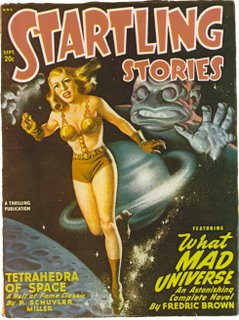The Thing That Came From The Newsstand
 Bright colors, threatening monsters and scantily clad girls made up the cover themes for the pulps over at Standard during the 1940s. Earl K. Bergey became the primary cover artist for both Startling Stories and its companion publication Thrilling Wonder Stories. A veteran of the Good Girl Art (GGA) school Bergey's art had graced the covers of magazines for some years before he was hired to attract readers to Startling and Thrilling Wonder.
Bright colors, threatening monsters and scantily clad girls made up the cover themes for the pulps over at Standard during the 1940s. Earl K. Bergey became the primary cover artist for both Startling Stories and its companion publication Thrilling Wonder Stories. A veteran of the Good Girl Art (GGA) school Bergey's art had graced the covers of magazines for some years before he was hired to attract readers to Startling and Thrilling Wonder.The covers became fodder for the letter columns. Some praised the art while others complained about being ashamed to be seen reading such stuff. But Bergey did his job and his eye-catching art graced these titles until his death in 1952.
By the time I began reading Sci Fi the pulps were a thing of the past and the surving titles Analog (formerly Astounding), Galaxy, The Magazine Of Fantasy And Science Fiction, and others sported more respectable covers featuring excellent work by Frank Kelly Freas and Ed Emshwiller, among others. Spacecraft began to look a bit more realistic and the art still conveyed Sense Of Wonder.
It took me a while to get into the magazines. I read paperbacks by Heinlein and Bradbury, but I approached the magazines slowly. Then in 1973 I discovered the pulps and fell in love with the stories of the 30s and 40s. After all, the pulps were the predecessors of my early favorite TV shows like COMMANDO CODY, JET JACKSON (the syndicated title for Captain Midnight) and ROCKY JONES. Not to mention the wonderful Sci Fi flicks of the 1950s from Universal and Columbia. I also developed a fondness for the giant bug movies of Bert I. Gordon, a man who could work wonders on a small budget. And, the Republic serials were now showing on TV with titles like KING OF THE ROCKETMEN and ZOMBIES OF THE STRATOSPHERE (which featured a young Leonard Nimoy as a Martian).
I have almost completed my collection of Startling Stories. I need only five more issues. Then I'll go after more Wonder Stories in its various incarnations. Classic stories? Maybe a few, but mostly not. But the writers could certainly tell a story and take you into the future for a couple of hours.

0 Comments:
Post a Comment